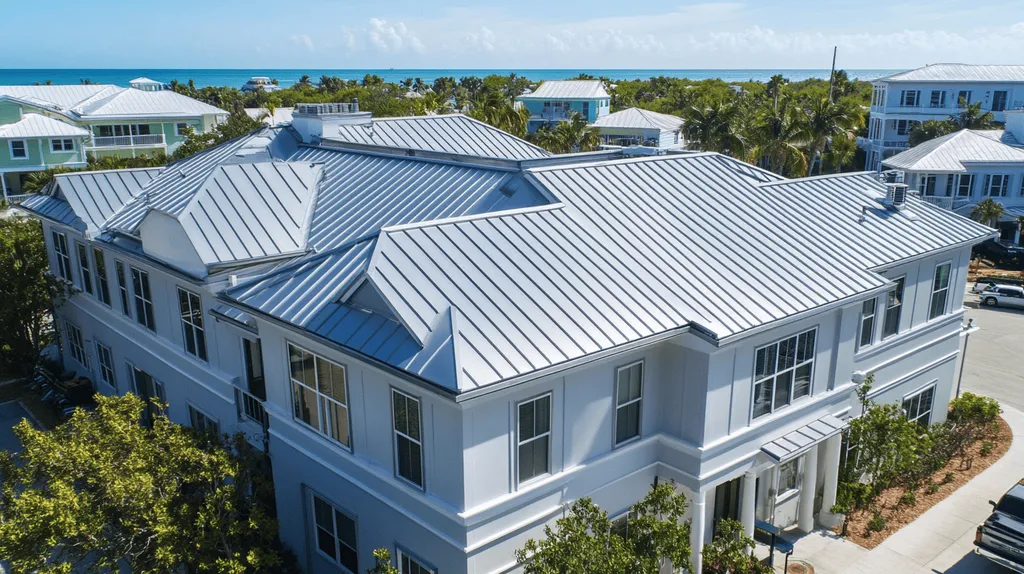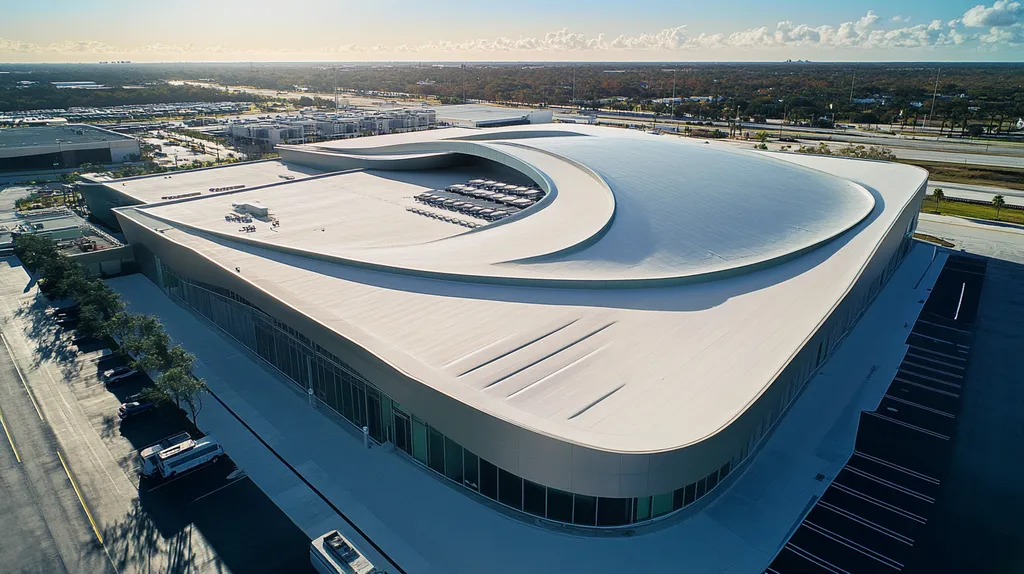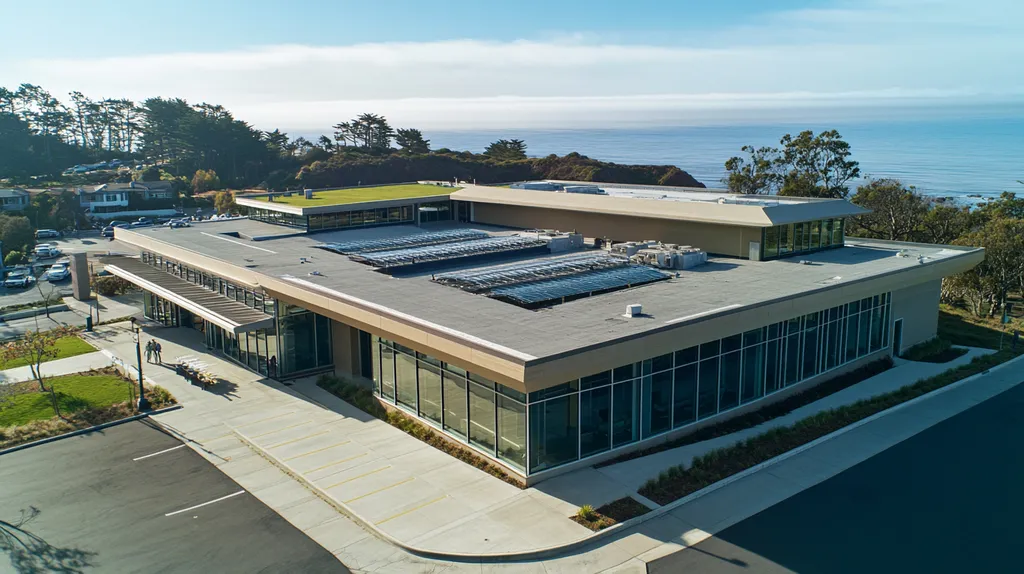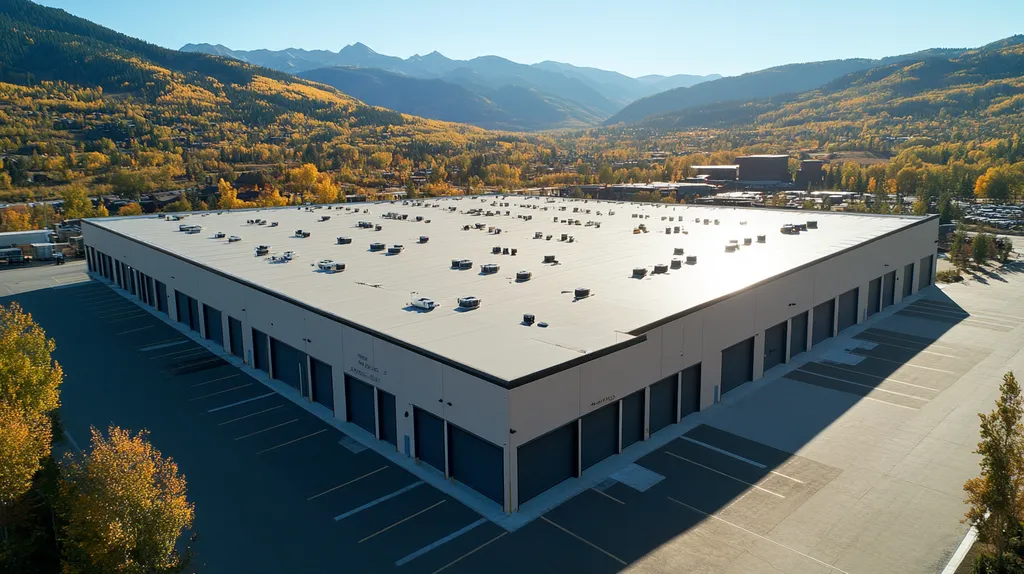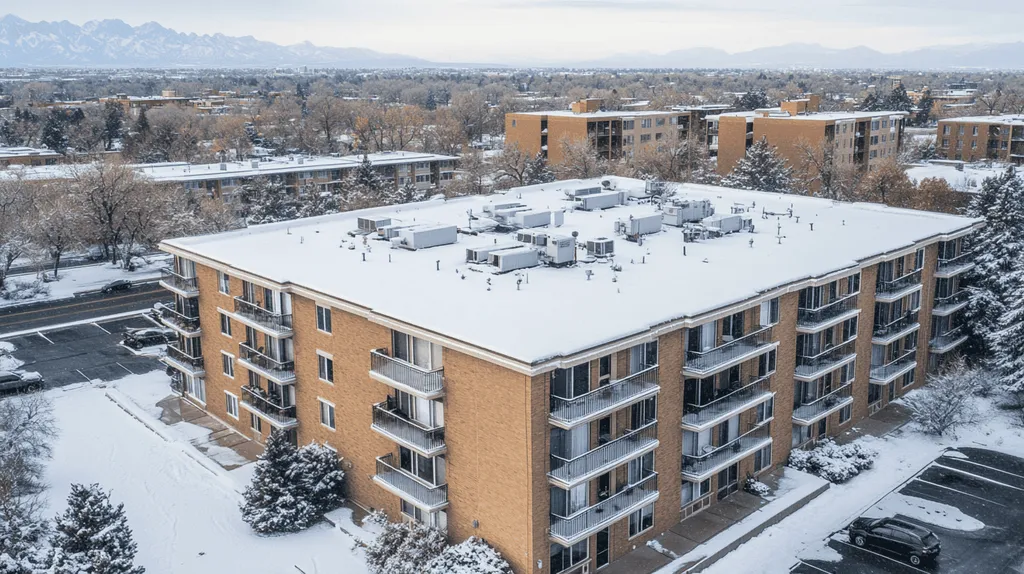Weather-related damage costs industrial property owners over $1.4 billion annually in the United States, yet many continue to operate under dangerous misconceptions about their roofing systems’ resilience.
From UV radiation silently degrading materials to unexpected snow loads threatening structural integrity, weather impacts present complex challenges that demand careful attention.
This analysis separates documented facts from common fiction, examining how various weather conditions affect industrial roofs and providing evidence-based solutions for protecting these crucial assets.
SECTION 1: COMMON MISCONCEPTIONS
Property owners and facility managers often underestimate how drastically weather conditions can affect industrial roofing systems. Misconceptions surrounding UV damage, rainwater accumulation, and wind resistance can lead to severe, costly consequences. For instance, a lack of understanding about UV exposure can cut a roof’s lifespan by nearly 50%. This section aims to clarify three key misunderstandings that can jeopardize both safety and finances.
Ignoring UV Damage Effects
The impact of UV rays on industrial roofing is frequently underestimated. Many believe that modern roofing materials are fully resistant to UV damage, but prolonged exposure can gradually weaken these structures. This degradation often occurs beneath the surface, allowing roofs to lose their integrity without visible signs.
Failure to address UV damage can result in expensive repairs down the line, as unnoticed cracks and leaks can compromise safety. To maintain a roof’s durability, routine inspections should specifically look for UV-related deterioration.
Moreover, applying specialized coatings can significantly enhance a roof’s ability to resist UV rays. Overlooking these protective measures can lead to earlier-than-expected repair or replacement costs, making awareness of UV damage critical for maintaining roofing performance and longevity.
Underestimating Rainwater Accumulation
Another common misconception is that all industrial roofs are capable of efficiently handling rainwater runoff. In reality, inadequate drainage systems can cause dangerous water pooling, leading to potential structural damage. Accumulated water increases the weight on the roof and can result in mold growth, posing health risks and damaging valuable inventory stored below.
In addition, water can infiltrate even small cracks, which can escalate into significant leaks. Regular inspections should focus on ensuring proper drainage and evaluating the roof’s grading to mitigate these issues.
By being aware of and preparing against rainwater accumulation, facility managers can prevent costly repairs from emerging and minimize disruptions to their operations. Regular maintenance, like cleaning gutters and checking drainage systems, plays a vital role in safeguarding the roof’s integrity.
Believing All Roofs Are Wind-Resistant
The assumption that all roofs can withstand high winds is a critical misconception that can result in serious damage. Not all roofing systems are created equal; some are more vulnerable to wind damage due to their design. For example, low-sloped roofs are particularly susceptible to wind uplift, which can compromise the entire roofing structure.
Failing to understand the specific wind resistance ratings of a roof can lead to unexpected repair costs, particularly during severe weather events. Additionally, neglecting to secure loose components, such as flashing or perimeter details, can worsen wind-related vulnerabilities.
It is crucial for property owners to recognize that not all roofs offer the same level of wind resistance. Conducting thorough roof inspections and focusing on these elements—especially before storm seasons—can significantly enhance a facility’s safety and reduce potential repair expenses.
SECTION 2: PRACTICAL IMPLICATIONS
The performance of industrial roofs is deeply influenced by changing weather patterns, posing serious risks for property owners. For example, studies indicate that failing to address sun exposure can result in a 20% decrease in the lifespan of standard roofing materials. Recognizing these hazards is vital for informed decisions on roofing maintenance and upgrades. This section examines the detrimental effects of heat, moisture, and snow, underscoring their impact on roof durability and overall performance.
Sun and Heat Induced Material Deterioration
Intense sunlight and heat can significantly accelerate the deterioration of roofing materials. UV radiation, for instance, can cause membranes to crack, directly leading to leaks and potential structural failures. Single-ply roofing systems are especially susceptible, as heat can cause them to lose elasticity, resulting in expensive repairs if not promptly addressed.
A study from the National Roofing Contractors Association highlights that roofs located in sunny climates may experience temperature variations that weaken material bonds. This heat-induced fatigue can lead to increased maintenance costs and the need for early replacement. Such understanding is essential for facility managers aiming to extend roof lifespan.
To combat these risks, property owners should explore reflective roofing options that reduce heat absorption. Regular inspection schedules are also critical in identifying early signs of damage caused by sun exposure.
By investing in protective measures, property owners can enhance the longevity of their roofs and safeguard their assets against the expensive repercussions of heat damage.
Rain and Moisture Causing Structural Issues
Rain and moisture pose significant threats to industrial roofing systems. Water intrusion can lead to issues like mold growth, insulation degradation, and compromised roof structure. It is reported that commercial structures can suffer up to 30% of their overall damage from water-related problems.
Flat roofs particularly struggle with water pooling, which can increase the load and risk structural failure. Regular maintenance and inspections are essential for identifying and addressing drainage issues before they evolve into more significant concerns.
Choosing the right roofing materials is also crucial in combating moisture-related risks. Selecting systems designed specifically for humid environments can greatly reduce the likelihood of water damage.
Effectively managing moisture is key to preserving roofing functionality and minimizing costly repairs, reinforcing its importance in facility management.
Snow and Ice Accumulation Risks
Snow and ice accumulation create unique challenges for industrial roofs, especially in colder regions. The added weight from snow can surpass the load limits of many roofs, risking structural integrity. Reports indicate that roofs can collapse under just a few feet of snow, leading to injuries and substantial property damage.
Ice dams are another concern, forming at roof edges and blocking drainage, which can cause water to back up under the roofing material. This situation can create leaks and further internal damage, complicating maintenance efforts. Regular snow removal is a crucial preventative measure.
Property owners should also think about installing heating cables or ventilation systems to reduce ice formation. Incorporating proper design elements that take weight limits into account can avert critical oversights that can have serious repercussions.
Understanding the risks associated with snow and ice is essential for protecting industrial roofs against severe weather events and ensuring occupant safety. Regular inspections and proactive management strategies are vital to effective roof maintenance.
SECTION 3: COST OF MISINFORMATION
Neglecting roof maintenance due to misinformation can lead to considerable financial setbacks for industrial property owners. Research indicates that facilities that skip regular maintenance may incur repair costs as much as ten times higher during adverse weather events. Grasping the true costs related to weather impacts can save property managers substantial amounts over time.
Financial Consequences of Neglecting Maintenance
Overlooking essential maintenance can have severe financial repercussions for industrial buildings. Routine upkeep is crucial to prevent minor issues from evolving into major headaches. For instance, an unattended leak can lead to extensive water damage, necessitating a complete roof replacement.
Facilities that delay maintenance often face disproportionately high repair costs. Instead of managing minor repairs, owners are left grappling with significant expenses that affect their bottom line. These costs include not only repairs but also the revenue lost due to operational downtime during repair work.
Moreover, there’s a cumulative effect from deferred maintenance. As weather conditions worsen, the risk escalates, potentially resulting in even larger financial losses as the building’s overall integrity is compromised.
Investing in preventative maintenance can serve as a financial safety net against unpredictable weather events. Ultimately, the cost of proactive upkeep is minimal compared to the potential expenses incurred from inaction.
Unforeseen Expenses from Weather Damage
Weather-related incidents can result in unexpected expenses that can severely impact a facility’s finances. For example, hailstorms can compromise roofing materials, requiring costly emergency repairs. Without accurate information about roofing capabilities, property managers may unintentionally underplay their exposure to these risks.
Furthermore, when roofs incur damage due to erroneous assumptions about weather resistance, property owners frequently confront higher repair bills. Emergency fixes often come with increased material and labor costs due to the urgency of the situation.
Consequences of initial damage may also extend over time. Issues like mold growth, structural concerns, and interior damage can emerge as a result of disregarding early weather-related signs. The cumulative effect of each layer of damage can lead to expenditures that far exceed the cost of effective preventive measures.
By understanding the actual performance of their roofing system, property owners can better avoid these surprise expenses. Improved knowledge translates into more effective budget management when dealing with weather-related incidents.
Impact on Insurance and Liability
The misconception that roofs require minimal maintenance oversight can raise insurance premiums. Insurers often impose higher rates on properties that have a record of weather-related claims and poor maintenance documentation. This illustrates how misinformation can directly drive up operational costs.
Liability concerns also arise when a building fails to withstand harsh weather conditions. If a roof collapses or leaks because of ignored maintenance, property owners could face legal issues. Lawsuits and claims can pile on even greater financial burdens.
Insurance providers typically review maintenance history when underwriters assess policies. Properties that display a strong track record of maintenance may enjoy lower insurance premiums and more extensive coverage. This trend underlines the importance of proactive roofing care.
Ultimately, grasping the costs tied to misinformation regarding roofing helps in making better decisions. By emphasizing accurate information and diligent maintenance, property owners can protect their financial interests while also mitigating liability risks.
SECTION 4: REALITY CHECK
Weather plays a critical role in the longevity and functionality of industrial roofing systems. With damage from hail, wind, and heavy storms becoming more frequent, understanding the real impacts can save property owners significant costs in repairs and replacements. For instance, the Insurance Information Institute reports that commercial property losses from storm damage can exceed billions annually. This section delves into the actual effects of hail, the necessity of proper drainage systems, and the realities of wind and storm damage.
Actual Effects of Hail on Roofing Materials
Hail can inflict severe damage on industrial roofing materials, leading to leaks and structural issues. Studies reveal that roofs made from TPO and EPDM are particularly vulnerable, as impacts can create punctures and tears. Unfortunately, these damages may not be immediately visible, allowing problems to escalate over time.
According to the National Weather Service, hail can range from pea-sized to golf ball-sized, and even larger in extreme instances. The larger the hail size, the greater the potential for damage to roofing systems. Facilities in hail-prone areas must prioritize roofing materials designed specifically for impact resistance.
Opting for high-rated materials can significantly reduce long-term repair costs. Property owners should also seek materials that come with warranties against hail damage, providing peace of mind in case of future weather-related incidents. Regular inspections after hail storms are crucial for early damage identification, preventing costly repairs down the line.
Understanding the effects of hail helps facility managers make informed choices about roof materials and maintenance strategies. Ignoring this risk can lead to increased vulnerability and potential structural failures. Awareness of hail’s impact is vital for sound roofing decisions.
The Role of Proper Drainage Systems
Effective drainage systems are essential for maintaining the integrity of industrial roofs. Without proper drainage, pooling water can compromise roofing materials, leading to leaks and accelerated wear. Roofs that are flat or have low slopes are particularly susceptible to drainage-related issues.
Statistics indicate that 90% of roof failures result from poor drainage and maintenance, highlighting the importance of proactive measures. Facilities managers must conduct regular inspections and clear drains to prevent blockages that can cause water accumulation.
Implementing effective drainage solutions, such as scuppers and overflow drains, enhances roof performance by ensuring efficient water removal. These features can prevent damage and prolong a roof’s lifespan.
Investing in proper drainage technologies may yield significant cost savings over time. By addressing these critical systems, property owners can protect their investments and enhance safety in facility operations.
Understanding Wind and Storm Damage
Wind-induced damage can be detrimental to industrial roofs, particularly in regions prone to severe weather. High winds can lift and strip roofing materials, creating vulnerabilities that may lead to leaks and structural failures. Reports show that wind damage accounts for a substantial percentage of insurance claims related to roofing.
Understanding the local climate and the wind ratings of roofing materials is crucial for property owners. Roofs should be designed to withstand local wind speeds to avert catastrophic failures. Enhanced fastening systems and additional structural support are often necessary for buildings located in high-risk areas.
Regular inspections and maintenance play a vital role in mitigating storm damage risks. Facilities managers should schedule assessments after severe weather events to identify any wind-related issues. Early detection of damage allows for timely repairs, preventing escalating problems.
Additionally, educating staff about storm preparedness can further reduce risks. Awareness of potential threats helps ensure that necessary precautions are taken, protecting both the building and its occupants.
SECTION 5: EVIDENCE-BASED ALTERNATIVES
As weather-related damage threatens the integrity of industrial roofs, proactive measures become essential. The National Roofing Contractors Association reports that weather-related roofing issues lead to about $1.4 billion in damages annually in the U.S. This stark statistic underscores the need for property owners to adopt evidence-based alternatives that enhance roof longevity and resilience. This section discusses the benefits of reflective coatings, impact-resistant materials, and the critical importance of regular inspection and maintenance.
Using Reflective Coatings and Cool Roofing
Reflective coatings and cool roofing serve as essential components in modern roofing solutions. These technologies deflect sunlight, significantly reducing surface temperatures and energy costs. Research indicates that cool roofs can lower energy consumption by up to 20% in hot climates.
By keeping rooftop temperatures down, these coatings can extend the lifespan of roofing materials. For example, traditional dark roofs can exceed temperatures of 150 degrees Fahrenheit, whereas reflective surfaces remain much cooler. This reduction in heat minimizes thermal expansion and contraction, which are key factors in the deterioration of roofing materials.
Reflective roofs also work effectively with building insulation systems. When applied properly, they boost energy efficiency and create more comfortable environments for building occupants. Facilities utilizing this technology frequently see enhanced HVAC performance and reduced strain on heating and cooling systems.
Furthermore, reflective coatings contribute to sustainability goals mandated by local building codes. The initial installation costs are often balanced by long-term savings. Therefore, property owners have strong incentives to explore these eco-conscious roofing options.
Installing Impact-Resistant Roofing Materials
Impact-resistant roofing materials offer essential protection against severe weather conditions. Options like modified bitumen and select metal roofing are built to withstand hail, falling debris, and high winds. For properties located in weather-sensitive regions, opting for these durable materials can significantly cut repair costs over time.
Research demonstrates that roofs made from impact-resistant materials can better endure storms that might damage standard roofing systems. For example, facilities equipped with impact-resistant shingles often save thousands in repair and productivity costs following severe weather incidents.
Additionally, using these materials can lead to improved insurance premiums. Many providers offer discounts for properties with impact-resistant roofs, reflecting their lower associated risks. This can translate into substantial financial savings for conscientious property owners.
Equipping industrial buildings with resilient roofing is not just about protection; it significantly enhances the overall safety of operations. In an era where extreme weather events are on the rise, the adoption of impact-resistant materials has transitioned from a luxury to a necessity.
Implementing Regular Inspection and Maintenance
Regular inspection and maintenance are vital for extending a roof’s lifespan and optimizing its performance. A well-structured maintenance plan enables property owners to detect minor issues before they escalate into costly repairs. According to industry data, facilities that engage in routine inspections can lower their roofing repair costs by as much as 30%.
Inspections should specifically aim to identify signs of water damage, check structural integrity, and assess the functionality of drainage systems. Promptly addressing these elements helps avert potential issues exacerbated by extreme weather conditions. Taking immediate action during inspections can lead to significant cost savings in the future.
Moreover, maintenance activities such as clearing debris from roofs and gutters play a crucial role in preventing water pooling and related leaks. Proper upkeep ensures that roofing systems perform optimally during inclement weather. Keeping walking paths clear also minimizes slip hazards, promoting safety.
In an industry where downtime can yield substantial financial losses, prioritizing roof maintenance is key. Consequently, property owners must invest in a comprehensive maintenance strategy that emphasizes regular inspections and timely repairs to enhance the longevity and efficiency of their roofs.
SECTION 6: TEST AND VERIFY
In industrial roofing, the stakes are high when it comes to understanding how weather conditions impact roof performance. A staggering 25% of all roofing failures are directly tied to inadequate weather resistance, often resulting in costly repairs. Therefore, testing and verifying roofing systems is essential to ensure they can withstand elements like UV rays and heavy rain, ultimately protecting investments and maintaining structural integrity. This section will delve into critical testing practices and real-world case studies that underscore the need for durable, weather-resistant roofing solutions.
Case Studies of Weather-Resistant Roofing Systems
Case studies provide valuable insights into the effectiveness of various roofing systems. For instance, a manufacturing facility in Texas chose a thermoplastic polyolefin (TPO) roofing system specifically designed for UV resistance. After experiencing severe weather events, this roof showed minimal signs of wear, proving its durability. Similarly, a warehouse in Florida implemented a modified bitumen roofing system, which performed admirably against heavy rain and high winds.
These examples illustrate the significance of selecting materials backed by data and suitable for specific environmental challenges. By analyzing such case studies, property owners can make more informed choices. Investing in weather-resistant systems can lead to longer-lasting roofs, reducing future repair and replacement costs.
Moreover, these real-world scenarios emphasize the necessity of selecting roofs that meet rigorous testing standards. Property owners must thoroughly evaluate the effectiveness of weather-resistant features to ensure reliable protection from environmental elements.
The findings suggest that investing in resilient roofing solutions not only improves durability but also enhances operational continuity. Thus, informed roofing system choices can significantly mitigate risks associated with severe weather.
Testing for UV and Heat Resistance
Testing roofing materials for UV and heat resistance is critical in verifying their performance and longevity. Research has shown that prolonged exposure to unprotected UV rays can significantly degrade roofing materials. Therefore, adhering to established testing standards, such as ASTM G154, is integral for assessing material resilience.
Effective testing procedures involve exposing samples to simulated UV light and heat cycles to gather data on performance in real-world conditions. For instance, both TPO and EPDM materials have undergone extensive testing, exhibiting superior heat resistance compared to traditional asphalt roofs.
Manufacturers often base warranties on such rigorous test results, providing property owners assurance in their investment. Materials capable of enduring harsh environmental conditions tend to have longer lifespans, significantly benefiting the owner’s bottom line.
Ultimately, property owners should prioritize materials that have undergone comprehensive testing. A solid understanding of the science behind UV and heat resistance can lead to better roofing decisions that withstand the test of time.
Verifying Performance After Severe Weather Events
Post-storm inspections are essential for verifying the performance of roofing systems following severe weather events. These evaluations can pinpoint vulnerabilities that may have developed, ensuring the structure’s integrity and protecting valuable assets.
For example, a retail center in the Midwest faced considerable hail damage, prompting immediate inspections. The assessment revealed that the existing roofing system employed subpar materials unable to endure hail impacts. This led to a crucial decision to invest in a higher-performing roofing system.
Additionally, utilizing technology like drones can enhance the accuracy of inspections, especially after extreme weather. Drones can access hard-to-reach areas, allowing professionals to identify damage that might otherwise go unnoticed.
Ultimately, verifying roof performance after severe weather extends beyond damage assessment; it also feeds into future learning. Documenting findings can inform future material selections and practices, steering property owners toward more resilient roofing options.
The Bottom Line
Weather-related roofing failures cost industrial facilities over $1.4 billion annually, yet many continue operating under dangerous misconceptions about their roofs’ resilience.
The evidence clearly demonstrates that UV exposure, water accumulation, and severe weather events pose significant threats to industrial roofing systems when not properly addressed through evidence-based solutions.
Properties implementing comprehensive maintenance programs, selecting appropriate materials, and conducting regular testing report up to 30% lower repair costs and significantly extended roof lifespans.
As extreme weather events increase in frequency and intensity, facility managers must prioritize accurate information and proactive maintenance to protect their assets and ensure operational continuity.
The cost of inaction far exceeds the investment required for proper roofing system care and weather preparation.
FREQUENTLY ASKED QUESTIONS
Q. How does UV damage affect commercial roof performance?
A. UV damage can significantly weaken roofing materials over time, leading to hidden failures. While many assume modern roofs are fully resistant, prolonged exposure can cause unforeseen cracks and leaks. Regular inspections focused on UV deterioration are crucial for maintaining roof integrity and extending its lifespan.
Q. What are the effects of rainwater accumulation on industrial roofs?
A. Rainwater accumulation can lead to significant structural damage due to increased weight and potential leaks. Inadequate drainage systems can cause water pooling, inviting mold growth and compromising materials. Regular inspections and maintenance are essential to ensure proper drainage, safeguarding the roof against costly repairs.
Q. How can neglecting roof maintenance affect industrial roof costs?
A. Neglecting roof maintenance can significantly increase long-term costs due to escalated repair needs. Minor issues can develop into major problems, leading to extensive and costly repairs. Facilities that prioritize routine maintenance often save money through reduced repair expenses and downtime.
Q. What are the real impacts of hail on industrial roofing systems?
A. Hail can cause severe punctures and tears in roofing materials, leading to leaks. The size and intensity of the hail can greatly influence the extent of damage, often escalating issues that require urgent repairs. Selecting materials specifically designed for hail resistance is crucial for protection.
Q. How does proper drainage affect industrial roof longevity?
A. Adequate drainage systems are critical for preventing water pooling, which can shorten roof lifespan. Poor drainage can lead to leaks and structural damage, necessitating costly repairs. Implementing effective drainage solutions, such as scuppers, can greatly enhance the roof’s durability and performance.
Q. What alternatives can help enhance industrial roof durability?
A. Reflective coatings and impact-resistant materials significantly increase roof durability. These solutions offer protection against severe weather and improve energy efficiency. Regular maintenance, including inspections, also plays a vital role in extending roof lifespan and maintaining optimal performance.
Q. Why is testing roofing materials essential for performance verification?
A. Testing roofing materials is essential for ensuring their ability to withstand environmental conditions. Performance verification helps identify vulnerabilities, minimizing the risk of premature failures. Rigorous testing provides property owners with the confidence that their roofs will perform reliably during adverse weather events.


